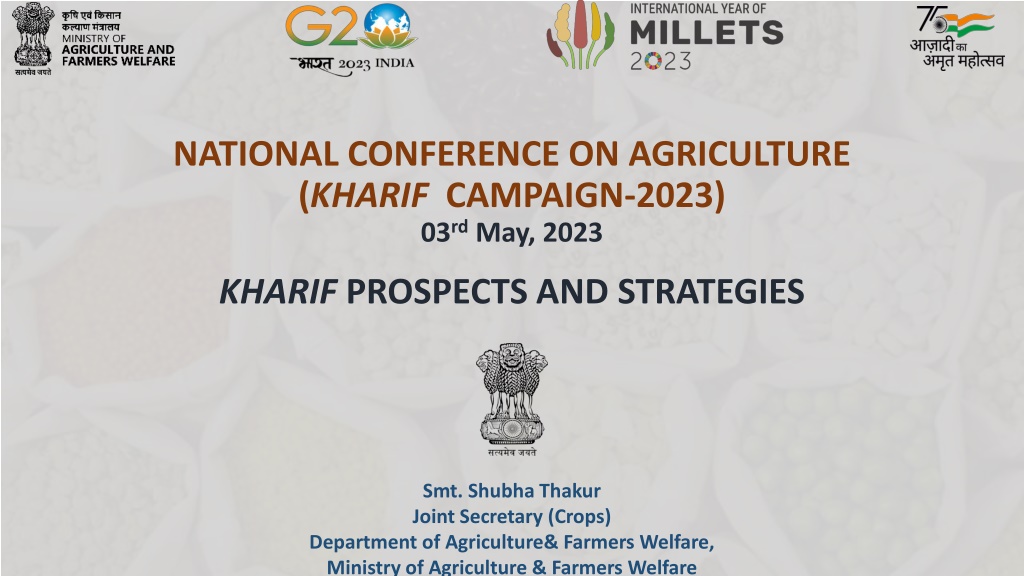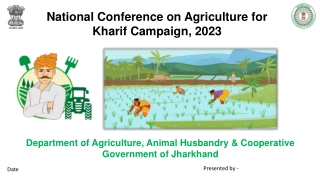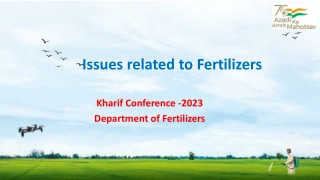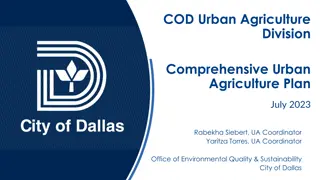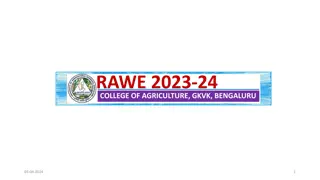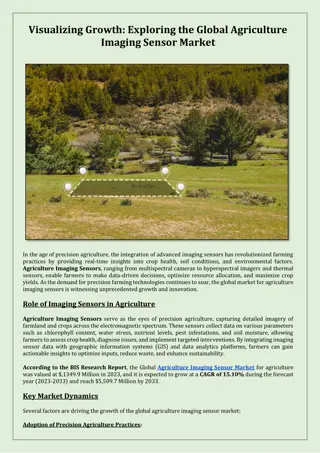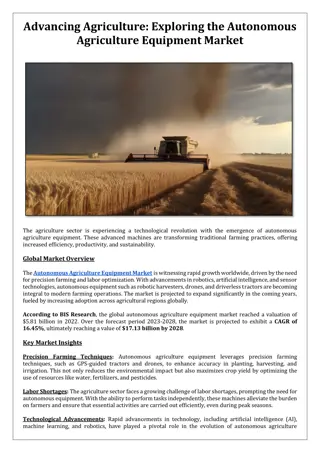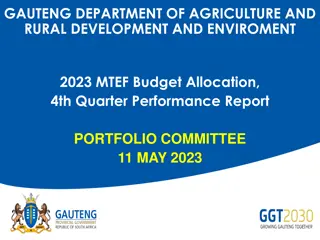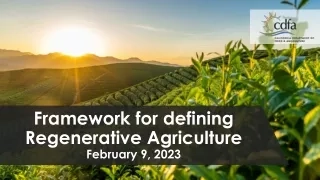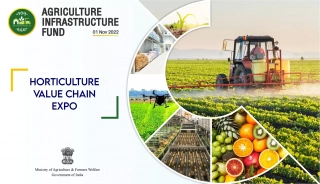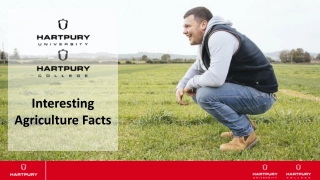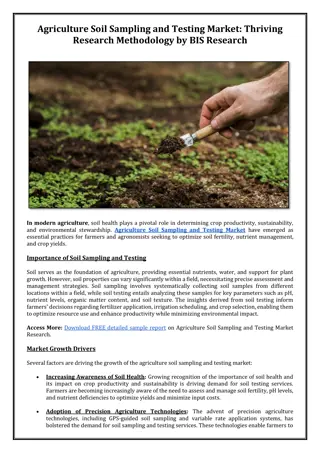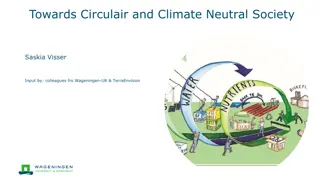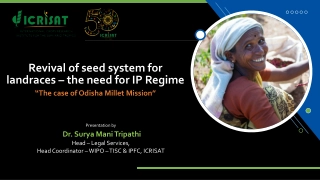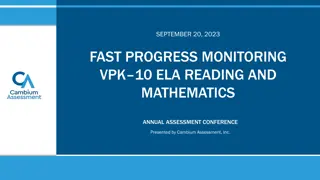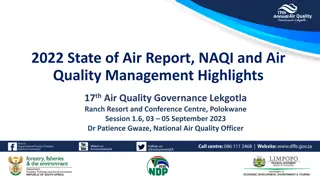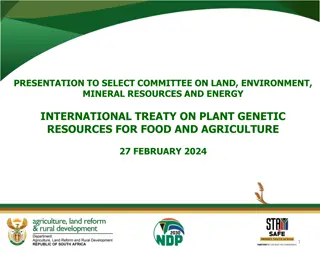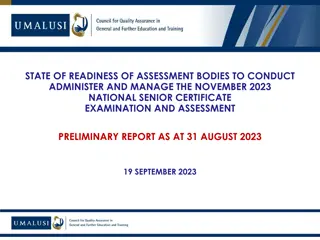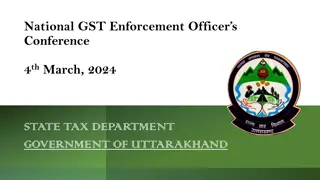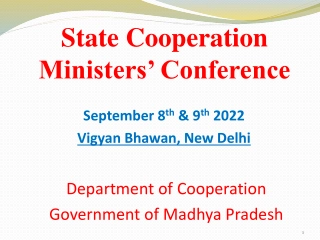National Conference on Agriculture (Kharif Campaign 2023) Highlights
The National Conference on Agriculture discussed Kharif prospects and strategies for 2023, including area and production of crops in 2022-23, rainfall data for Rabi and summer seasons, and region-wise live storage of water in major reservoirs. Insights on crop production, rainfall patterns, and water storage were shared, providing key information for the agricultural sector.
National Conference on Agriculture (Kharif Campaign 2023) Highlights
PowerPoint presentation about 'National Conference on Agriculture (Kharif Campaign 2023) Highlights'. This presentation describes the topic on The National Conference on Agriculture discussed Kharif prospects and strategies for 2023, including area and production of crops in 2022-23, rainfall data for Rabi and summer seasons, and region-wise live storage of water in major reservoirs. Insights on crop production, rainfall patterns, and water storage were shared, providing key information for the agricultural sector.. Download this presentation absolutely free.
Presentation Transcript
NATIONAL CONFERENCE ON AGRICULTURE (KHARIF CAMPAIGN-2023) 03rdMay, 2023 KHARIF PROSPECTS AND STRATEGIES Smt. Shubha Thakur Joint Secretary (Crops) Department of Agriculture& Farmers Welfare, Ministry of Agriculture & Farmers Welfare
NATIONAL CONFERENCE ON AGRICULTURE (KHARIF CAMPAIGN-2023) 03rd May, 2023 KHARIF PROSPECTS AND STRATEGIES Smt. Shubha Thakur Joint Secretary (Crops) Department of Agriculture& Farmers Welfare, Ministry of Agriculture & Farmers Welfare
AREA AND PRODUCTION OF CROPS IN 2022-23 (2nd Adv. Est.) Crops Area (Million hectare) Kharif 40.45 - 8.05 - 8.05 1.41 7.03 1.11 0.47 10.03 13.07 71.60 19.29 5.56 13.05 0.66 Production (Million tonnes) Kharif Rabi 108.08 22.76 - 112.18 23.83 10.78 - 2.20 23.83 12.98 1.53 2.54 9.79 1.67 0.38 13.37 2.54 8.16 19.65 153.43 170.12 25.37 14.63 468.79 33.72 10.05 Rabi 6.60 31.87 2.03 0.74 2.76 2.31 - - - 2.31 17.04 60.58 9.97 Total 47.05 31.87 10.08 0.74 10.81 3.72 7.03 1.11 0.47 12.34 30.10 132.18 29.26 5.56 13.05 0.66 Total 130.84 112.18 34.61 2.20 36.82 4.08 9.79 1.67 0.38 15.91 27.81 323.55 40.00 468.79 33.72 10.05 Rice Wheat Maize Barley Total Coarse cereals Sorghum Bajra Ragi Small millets Total Shree Anna Total Pulses Total food grains Total oil seeds Sugarcane Cotton @ Jute & Mesta $ @ Thousand bales of 170 kgs each. $ Thousand bales of 180 kgs each. - - -
RAINFALL RABI & SUMMER SEASON (mm) Meteorologic al Subdivisions Monsoon 2022 (01.10.22 to 31.12.22) Post-Monsoon, 2022 (01.10.22 to 31.12.22) Winter - 2023 (01.01.23 to 28.02.23) March 2023 Onward (01.03.23 to 30.04.23) Actual Normal % Actual Norma % Actual Normal % Actual Normal % Dep. l Dep. Dep. Dep. East & North East India 47.7 44.4 7% 176.5 158.9 11% 21.2 47.2 (-)55% 130.7 183.2 (- )29% North West India 2.8 7.7 (-)64% 82.8 52.6 57% 54.3 78.7 (-)31% 84.8 79.8 (+) 6% Central India 20.8 23.3 (-)11% 94.8 76.1 25% 1.9 14.9 (-)87% 53.7 17.0 (+)21 6% South Peninsula 37.5 41.6 (-)10% 298.1 274.1 9% 6.3 15.7 (-)60% 71.5 49.4 (+)45 % Country As A Whole 22.8 25.5 (-)10% 144.1 121.0 19% 21.9 39.8 (-)45% 79 69.2 (+)14 %
Region-wise Live Storage of Water in Major Reservoirs (2022 & 2023) as on 27.04.2023 Storage As Percentage Of Live Capacity At Frl Live Storage (Bcm) Live Capacity At Frl (Bcm) Region 2021-22Last 10 Yrs. Last 10 Yrs. Average 2022-23 2022-23 2021-22 Avg. Northern Region 19.66 7.42 6.10 6.14 38% 31% 31% Eastern Region Western Region 20.09 6.90 6.69 7.40 34% 33% 37% 37.13 14.14 15.76 11.651 38% 42% 31% Central Region Southern Region 48.23 20.55 18.98 16.58 43% 39% 34% 53.07 15.12 19.09 11.61 28% 36% 22% Country As A Whole 178.18 64.13 66.63 53.39 36% 37% 30% 146 3 35 21 87 Reservoirs: >80% capacity of normal storage Reservoirs: 51%-80% capacity of normal storage Reservoirs: 41%-50% capacity of normal storage Reservoirs: upto 40% capacity of normal storage Total Reservoirs Source: CWC GoI. As on 27.04.2023
Status of Area Sown for Summer Crop As on 28.04.2023 Area Sown (Area in Lakh ha) Current Year 2023 27.45 17.57 14.27 3.08 0.23 Sl. No. 1 2 Increase/ Decrease -1.68 1.34 1.43 -0.03 -0.05 Crops Last Year 2022 29.14 16.23 12.84 3.12 0.28 Rice Pulses a) Greengram b) Blackgram c) Other Pulses Shri Anna -cum -Coarse Cereals a) Jowar b) Bajra c) Ragi d) Maize Oilseeds a) Groundnut b) Sunflower c) Sesamum d) Other Oilseeds Total 3 10.86 10.19 0.67 0.15 4.29 0.12 6.30 9.40 4.50 0.29 4.36 0.25 65.29 0.15 3.59 0.20 6.24 10.46 5.27 0.31 4.20 0.68 66.02 0.00 0.70 -0.08 0.06 -1.06 -0.77 -0.01 0.16 -0.44 -0.73 4
Tentative requirement & availability of seeds for major crops in kharif-2023 Crops Group Crop Requirement (in 000' Quintals) Availability (in 000' Quintals) Surplus/Deficit (in 000' Quintals) Paddy 7703.51 8360.00 656.49 1. Cereals Maize Bajra Jowar 1080.72 245.16 115.58 1159.80 273.50 130.65 79.08 28.34 15.07 2. Nutri-Cereals Millets 65.15 84.14 18.99 Arhar 296.47 332.96 36.49 3. Pulses Urd Moong Cowpea Moth Groundnut Soybean Sunflower Sesame Castor 220.45 253.41 435.64 21.13 2006.70 3474.92 13.31 15.28 47.26 251.30 302.64 439.14 27.40 2118.73 3702.81 16.96 18.97 49.90 30.85 49.23 3.50 6.27 112.03 227.89 3.65 3.70 2.64 4. Oilseeds
Requirement & sales of fertilizers in 2022 and requirement in 2023 during kharif season KHARIF: 2022 KHARIF: 2023 Fertilizers Assessed requirement Total sales Assessed requirement Urea 179.01 172.61 178.69 DAP 58.82 51.60 55.19 MOP 19.82 7.13 15.02 NPK 63.72 52.07 62.71 SSP 33.19 26.42 33.76 Total 354.56 309.83 345.37 Use of Bio-fertilizers, Neem Coated urea, Use of Micro-nutrients Source: INM & FMS, DAC, GOI
Proposed National Crop Production targets for 2023-24 Crop Kharif Season Rabi Season Summer season Total Rice Wheat 111.00 14.52 114.00 9.75 2.25 12.00 2.53 8.48 134.00 114.00 35.50 2.25 37.75 4.50 10.30 1.80 0.40 17.00 4.30 13.65 2.92 3.98 0.80 3.60 - - Maize Barley 24.00 1.75 - - Total Coarse Cereals Jowar Bajra Ragi Small Millets 24.00 1.91 9.93 1.73 0.40 13.97 4.30 1.75 0.06 0.37 0.07 - - - - Total Shree Anna Tur (Arhar) Gram 2.53 0.50 - - - - 13.65 0.60 0.32 Urad Moong Other Kharif Pulses Other Rabi Pulses 1.97 2.02 0.80 0.35 1.64 - - - - 3.60
Proposed National Crop Production targets for 2023-24 Crop Kharif Season Rabi Season Summer season Total Total Pulses 9.09 18.17 1.99 29.25 Total Foodgrains 158.06 161.22 12.72 332.00 Total Oilseed 28.37 14.49 1.14 44.00 Sugarcane 470.00 - - 470.00 Cotton* 35.00 - - 35.00 Jute** 10.05 - - 10.05 Mesta** 0.45 - - 0.45 Jute & Mesta** 10.50 - - 10.50 * Production in Million bales of 170 kg for Cotton, ** Production in Million bales of 180 kg for Jute & Mesta.
Strategies For Pulses And Oilseeds Crop specific district-wise micro planning to increase production and productivity: 370 in pulses and 340 in Oilseeds Record production in 2022-23 (in Lakh Tonnes): 278.10 in Pulses and 400.00 in Oilseeds Production target during 2023-24(in lakh Tonnes): 292.50 in Pulses and 440.00 in Oilseeds More than 70% demonstration being organised in these selected districts Enhancement of ceiling on quantity of procurement under PSS from existing 25% to 40% w.r.t. Tur, Urad and Masoor 15 Lakh ha area of pulses and oilseeds to be brought in rice fallow Around 38.74 lakh of seed mini kits of various oilseeds has been allocated during Kharif, Rabi and Summer, 2022-23 Around 24.64 lakh of seed mini kits of various Pulses has been allocated during Kharif, Rabi and Summer, 2022-23 Central Agriculture University, Imphal to establish 3 COEs in Oil Palm in Arunachal, Manipur and Mizoram Patanjali Food Pvt Ltd and 3F have set up one (01) Oil Palm Processing Mills each in Arunachal Pradesh Proposed to achieve 54.10 million tonnes of edible oilseeds by 2025-26 and to reduce import dependency from 56% to 36% by 2025-26.
Efforts for crop diversification ICAR developed 20 Agro-Ecological Regions (AERs) for crop planning and agriculture development in the country. Advisory issued to states requesting them to further strengthen their efforts on AER based planning. States have already started AER wise planning and its sustainable implementation. Oilseeds and pulses are promoted through AER wise planning to make country self sufficient in these commodities. A project on Crop Diversification in 5 million hectares in five years in identified 75 districts in 17 states representing 14 agro-ecological zones of the country has been approved to ICAR-IIFSR, Modipuram for its implementation during 2023-24 to 2027-28.
Special Project on Cotton Cotton is an important fibre and cash crop that plays a dominant role in the industrial and agriculture economy of the country. In view to increase the productivity of cotton & production of ELS cotton, a special project on cotton with a cost of Rs 41.87 crores has been approved under NFSM for implementation during 2023-24 identified cluster through value chain approach. ICAR - Central Institute for Cotton Research [CICR], Nagpur is the nodal implementing institute of this project involving farmers, states, industry, seed associations, KVK s etc. on PPP mode. The project would be implemented in an estimated area of 15358 ha in 295 clusters, 57 districts of 8 states (Rajasthan, Gujarat, Madhya Pradesh, Maharashtra, Telangana , Andhra Pradesh , Karnataka & Tamil Nadu). The assistance under the project is to be provided to small and marginal farmers through DBT with validation of beneficiary Farmers by State Governments along with Geo referencing of project sites.
Let Us Strategize Accordingly States to strengthen their efforts on agro-ecological region based planning. Adopting cluster approach for crop productivity enhancement Cropping system centric interventions : Focus on Pulses, Oil seeds, Shree Anna, etc. Utilization of rice fallow, rice bunds, intercropping, rainfed areas, expansion area under summer season. Increasing Seed Replacement Ratio and Varietal Replacement to overcome impact of climate change. Increasing water & nutrient use efficiency and large scale adoption of improved technologies Convergence of interventions of the schemes of DA&FW for effective implementation and avoiding duplication.
Preparedness (States) Timely arrangement of Seeds, fertilizers, micronutrients, pesticides, machinery, credit, etc. Ensure timely crop insurance cover for the farmers. Considering the IMD forecast for normal monsoon this year with predicted rainfall of 96% (+/-) 5% of LPA, states to be prepared for drought monitoring and its management for any eventuality. Regularly review crop input availability and follow up. Focus on enhancing yield of oilseeds and pulses special thrust may be given for Urd and Tur for the ensuing Kharif season to achieve self sufficiency in these commodities. Special focus on Shree anna, its popularisation, making availability of quality seeds to keep pace with the growing demands of this healthy food during the International year of millets.
PREPAREDNESS (ICAR) ICAR-CRIDA to update the District Agriculture Crop Contingency plans (DACPs), incorporating the drought tolerant crop varieties and crop specific resilient technologies. Timely issue of advisories to the states/farmers, farmer groups etc. Preparing Agro-ecological region-wise road map for reducing yield gap of various crops through improved varieties and technologies. Sensitizing the KVKs, SAUs and other ICAR institutes for better coordination with the states/district agricultural officials for effective and timely implementation. To collate data & analyse the impact of demonstrations on the other farmers and acceptability of the particular technology/intervention among the farmers. To identify low yield areas of the major crops and prepare road map to address the issues with improved technologies/interventions.
PREPAREDNESS (DA&FW) Close monitoring of flow of funds for advance planning and strategize effective implementation of various schemes by the states. Convergence with ATMA and other centrally supported schemes. Weekly video conferencing with states to review crop situation, input availability and pest & diseases status & follow up action for timely supply of inputs for states/farmers. Drought Monitoring cell of DA&FW to ensure sensitization and training programmes for the states to bring awareness and use of the contingency plans at block and panchyat level.
Thank You
